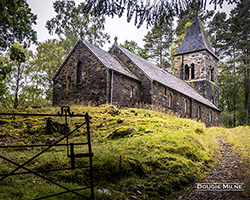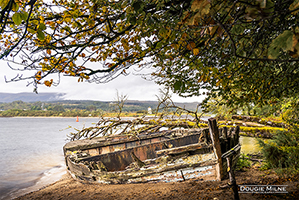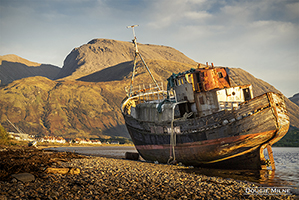The Great Glen Way Wall Art
Back in 2015, my wife and I accomplished our first long distance hike, when we walked from Milngavie to Fort William along the West Highland Way. Although we have done a great deal of walking in the Scottish countryside in the years since then, we have never done another of Scotland's Great Trails, the collection of long-distance walking routes which criss-cross the length and breadth of the country. Like everyone else, by the end of the first lockdown in 2020, we were anxious to taste freedom again, and decided that it was time to don our hiking boots and attempt a second long-distance hike. This time, we chose to pick up where we left off in 2015, starting in Fort William and following the Great Glen Way north-east to Inverness, making a complete traverse from one side of Scotland to the other by foot. The Great Glen cleaves through the Highlands between the two towns. Both a fault line and a glacial trough, this deep, 57-mile-long trench splits the landscape in two. Steep, forested slopes drop down to Loch's Ness, Lochy and Oich, artfully arranged by Mother Nature in a straight line through the glen. With no mountain barriers, it has provided an obvious route for anyone wanting to cross from one side of the Highlands to the other for hundreds, if not thousands of years. St Columba was travelling through it on his way to convert the Picts to Christianity when he made the first recorded sighting of the Loch Less Monster. General George Wade built a military road through it, connecting his Forts William, Augustus, and George, to subjugate the clans following the 1715 Jacobite uprising. Thomas Telford built the Caledonian Canal through it to provide an alternative shipping route to the treacherous journey around Cape Wrath and the Pentland Firth. Today, the A82 runs through it, traversing some of Scotland's most spectacular scenery and promising one of the UK's finest road trips. The Great Glen Way was first proposed back in the 1970s by the Scottish Rights of Way Society and was opened on 30 April 2002 by the Earl of Inverness, Prince Andrew. It was Scotland's fourth long-distance path, following on from the West Highland Way, Southern Upland Way and Speyside Way. It cost around half a million pounds to create, but the villages along the route benefit from around two million pounds of increased tourism revenue annually. The low-lying, 79-mile (127km) trail is traditionally walked from Fort William to Inverness, passing through Invergarry, Fort Augustus and Drumnadrochit, providing an easy and scenic walking route through the Highlands, with ready access to accommodation, food, drink, and transport services. It makes substantial use of the canal towpath, particularly at its southern end, but also traverses forestry tracks, a disused railway line and an old drovers' road, taking in loch shore, hill, moor, beautiful Caledonian pine forest and birch woodland. Red squirrels and pine martins scamper among the trees, while ospreys and golden eagles hunt for prey on the lochs. Native roe and red deer, as well as Japanese sika deer, can often be seen galloping across the hillside and moorland. There are ancient castles, reflecting the turbulent history of clan rivalry, and the more recent history of World War Two Commando training areas. The Great Glen Way is one of the easiest long-distance trails and is well within the capabilities of any reasonably fit person. The first half of the route, as far as Fort Augustus, is on low, level and easily navigated canal towpaths, old railway trackbed and forestry roads. It gets tougher after that, traversing the hills and high moorland to the north of Loch Ness. However, the path is well-constructed and waymarked throughout, and is virtually impossible to get lost on. Nevertheless, seventy-nine miles is still a long walk, and hiking ten or more miles each day requires stamina. It is important to choose the schedule carefully so that what should be a pleasant walk does not become an endurance exercise. Some people choose to camp along the way, carrying everything that they need to survive with them, and either wild-camping or stopping off at the many official camping spots. However, we like a bit of luxury with our walking, and opted to stay in B&Bs in the villages along the Glen. You can't beat a hot shower at the end of a day's hiking, and the pubs and restaurants along the Way serve excellent food. Staying in accommodation also allowed us to use a luggage carrying service to cart our belongings from one place to another, meaning that the only things we needed to put in our rucksacks were food and drink (along with maps, a compass, and a first-aid kit - although we did not use any of them, it is always better to have and not need than to need and not have). In my case, I also chose to lug my photography equipment, more and more of which found its way out of my rucksack and into my suitcase as the journey progressed. The record for completing the route on foot was set in 2014, when Mike Raffan finished in 10 hours, 48 minutes and 43 seconds. However, you are traversing some of Scotland's most spectacular scenery, and I would advise a more leisurely pace, allowing you the time to stop off at cafés, enjoy the wildlife and enjoy the views. The villages along the route are spaced at roughly 10- to 15-mile distances, and this dictates how long it takes to complete the whole walk. Most walkers take six or seven days to complete the Way's six stages, but those with more time to spare might consider combining the route with the West Highland Way, giving a 175-mile (282km) walk from Glasgow to Inverness, offering some of the best scenery that the world has to offer and the opportunity to appreciate it on foot. My choice to take my camera influenced our decision to complete the hike in as long a time as possible. As a landscape photographer, I am used to carrying a heavy backpack over long distances, but the shorter daily distances allowed me the time to stop and set up my tripod, and to fine-tune compositions - a luxury that I would not have had otherwise. We also opted to have a day off in Drumnadrochit, on the shores of Loch Ness, and to spend the afternoon at Urquhart Castle. One of the most-visited castles in Scotland, with over half-a-million visitors in 2019, it was eerily quiet during our mid-pandemic visit. In retrospect, spending an extra day in Fort Augustus and taking in a cruise on Loch Ness would have been agreeable too, and if we were to do it again, I would allow time for this. The Great Glen Way can be walked at any time of the year, although Scotland's notorious weather and short winter days can make walking the route between November and March wet and unpleasantly cold. We chose to walk it in early October, when the midges are dead, and the autumn colours and low sun make the best photographs. We enjoyed the diversity of the route, from canal towpath to abandoned railway to forest path to high moorland track, it is walking in Scotland in a nutshell. Once you are away from the villages, the path is quiet, with just the wildlife for company, but civilisation is never too far away. We will definitely be back.
Select a picture for further information
Tweet


